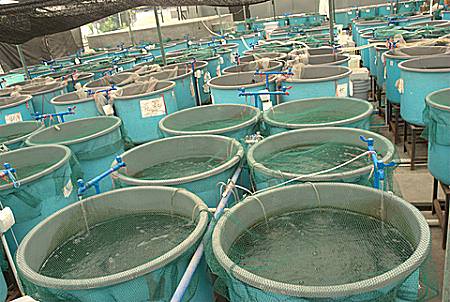| Back to Back Issues Page |
 |
|
The Goldfish Gazette, Issue #041 -- Commercial Goldfish Culture May 29, 2017 |
Goldfish Care Tips and GuidelinesA Free Monthly Resource For Goldfish Enthusiasts In This Issue
Breeding and raising Goldfish to sell is worthwhile for amateur breeders, but you have to be selective about what you choose to breed. Commercial Goldfish Culture
This short e-Zine can’t possibly cover all the requirements for raising Goldfish commercially. What I want to highlight is some of the early decisions that need to be made to avoid raising fish nobody wants, or fish that will give you very little money for your efforts. Extensive vs. Intensive CultureMost Goldfish farms in the US use extensive growing methods, not intensive as shown in the image above of a typical Asian fish farm.With extensive culture the grower has large ponds of say several acres which are stocked in early spring with fry. At the end of the growing season, having done nothing but feed the fish, the pond is drained and the fish that have survived are sorted for sale. Most of the large Goldfish farms grow varieties that don’t require much, if any culling such as Comets and metallic scaled Fantails. Any defects such as single tails in the Fantails would be picked up during sorting. For most amateur breeders, intensive growing methods are used because of lack of space. This means pond stocking levels are high, disease outbreak is common, the breeder must supply all the food, and the numbers of saleable fish produced is low. All these factors have a bearing on what varieties the amateur breeder should breed, and by using the 4 Ps of marketing, Product, Price, Place and Promotion, the amateur breeder can work out what varieties will be the most profitable. Right ProductBy right product we mean breeding the variety that will give us the most money for our efforts while satisfying what our customers want. This doesn’t necessarily mean a high price for each fish. It is a combination of price and the number of fish that can be sold. Here are a couple of examples.Comets are produced in huge quantities because they are easy to grow and are popular. Because there is no supply problem, their cost is low to the customer. The breeder gets very little money for each fish. The amateur breeder doesn’t want to breed Comets to sell. If the amateur breeder wants to breed Water Bubble Eyes, a variety that is rarely grown by commercial breeders, how many can be sold in his/her market? Water Bubble Eyes aren’t as popular as Comets, and their cost is much higher, so the number that are sold is tiny compared to Comets. Right PriceThe price you can charge for your fish will depend on size, availability and variety, but above all else, your customer must think your fish are worth what you are asking.This is where quality is extremely important. If you are selling Black Moor with single tails, the price you get isn’t going to be as high as for fish with two tails. Right PlaceThe right place is referring to where you are selling your fish. Are you selling to a wholesaler, a retailer (pet shop), or directly to the public? A wholesaler will take all your fish, but at the lowest price. A retailer may only take 10-20 fish every few months and will pay what the wholesaler charges (or less).If you can sell directly to the customer, you will get the best price, but you need to have some sort of premises suitable to sell from that is convenient for your customers. Right PromotionYou need to be able to reach your customers, especially if you are selling at near retail prices. This is where the Internet comes into its own. Before the Internet, I struggled to sell Water Bubble Eyes. These days I have no trouble selling Bubble Eyes or surplus fry.If you can’t reach customers directly through promotion, you will have to sell to wholesalers and/or retailers. In Conclusion….Breed fancy varieties that are popular and you know your market is big enough for the numbers you can grow. Black Moor are usually a safe option as are Orandas.Keep your quality high. Get a name for growing high quality fish. Wholesalers and retailers have no trouble selling high quality fish. When selling directly to the public, you must only sell high quality fish. Don't be afraid to ask a high price for exceptional fish, as most fish in pet shops are very low quality. Comments? Ideas? Feedback? I'd love to hear from you. Just reply to this e-zine and tell me what you think, or what topics you want covered. Next Month's Topic Daphnia Culturewww.facebook.com/aboutgoldfish |
| Back to Back Issues Page |